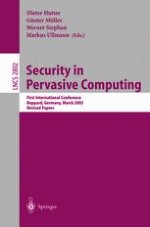
2004 | OriginalPaper | Buchkapitel
The Age of Pervasive Computing – Everything Smart, Everything Connected?
verfasst von : Friedemann Mattern
Erschienen in: Security in Pervasive Computing
Verlag: Springer Berlin Heidelberg
Enthalten in: Professional Book Archive
Aktivieren Sie unsere intelligente Suche, um passende Fachinhalte oder Patente zu finden.
Wählen Sie Textabschnitte aus um mit Künstlicher Intelligenz passenden Patente zu finden. powered by
Markieren Sie Textabschnitte, um KI-gestützt weitere passende Inhalte zu finden. powered by
Given the continuing technical progress in computing and communication, it seems that we are heading towards an all-encompassing use of networks and computing power, a new era commonly termed ”Pervasive Computing”. Its vision is grounded in the firm belief amongst the scientific community that Moore’s Law (i.e. the observation that the computer power available on a chip approximately doubles every eighteen months) will hold true for at least another 10 years. This means that in the next few years, microprocessors will become so small and inexpensive that they can be embedded in almost everything – not only electrical devices, cars, household appliances, toys, and tools, but also such mundane things as pencils (e.g. to digitize everything we draw) and clothes. All these devices will be interwoven and connected together by wireless networks. In fact, technology is expected to make further dramatic improvements, which means that eventually billions of tiny and mobile processors will occupy the environment and be incorporated into many objects of the physical world.Together with powerful and cheap sensors (and thus the ability to sense the environment), this progress in processor and communication technology will render everyday objects ”smart” – they know where they are, and they may adapt to the environment and provide useful services in addition to their original purpose. These smart objects may form spontaneous networks, giving rise to a world-wide distributed system several orders of magnitude larger than today’s Internet.It is clear that we are moving only gradually towards the ultimate vision of Pervasive Computing. Much progress in computer science, communication engineering, and material science is necessary to render the vision economically feasible and to overcome current technological hurdles. However, the prospects of a world of things that virtually talk to each other are fascinating: many new services would then be possible that transform the huge amount of information gathered by the smart devices into value for the human user, and an entire industry may be set up to establish and run the underlying infrastructure for the smart and networked objects.Clearly, there are also many issues on the political, legal, and social level to consider. Privacy is certainly a primary concern when devices or smart everyday objects can be localized and traced, and when various objects we use daily report their state and sensor information to other objects. The repercussions of such an extensive integration of computer technology into our everyday lives as Pervasive Computing advocates it, are difficult to predict and only time will tell whether this technology does contribute to a better and more enjoyable world or, on the contrary, promote a more totalitarian regime.